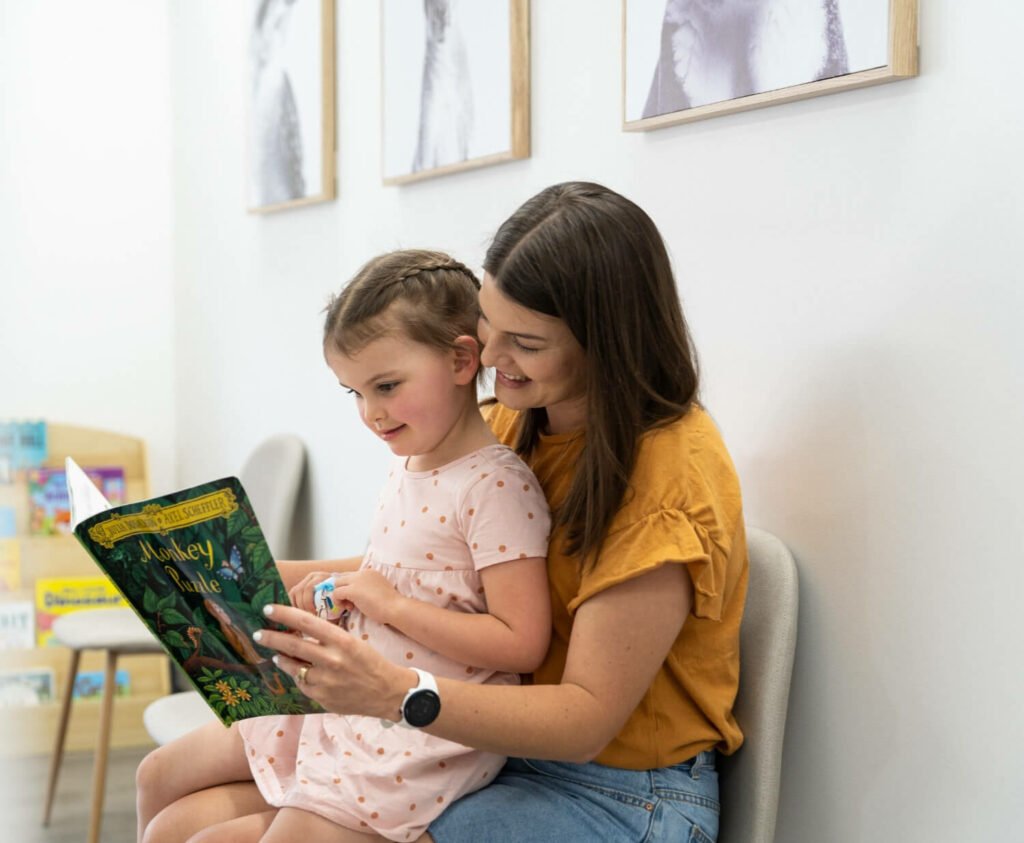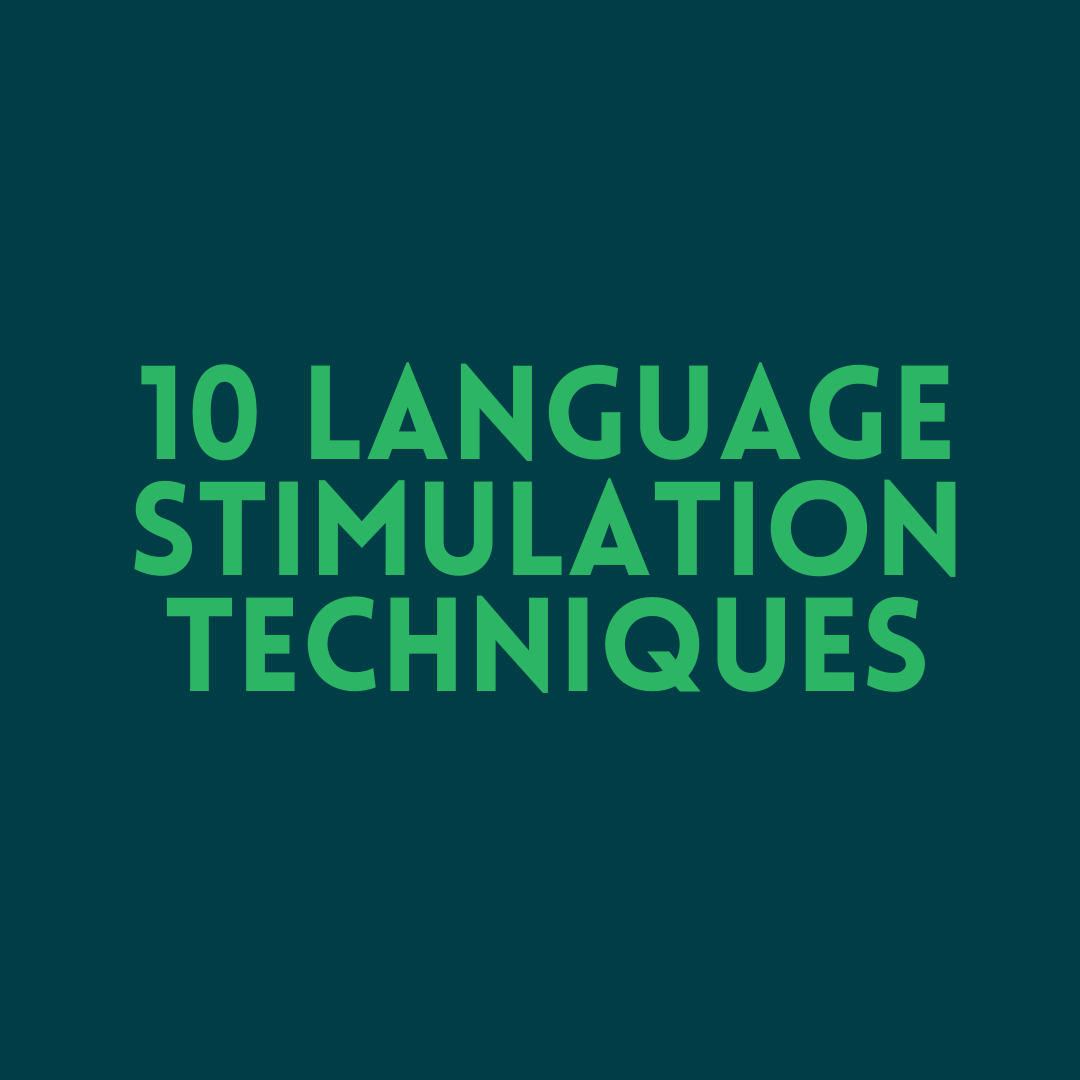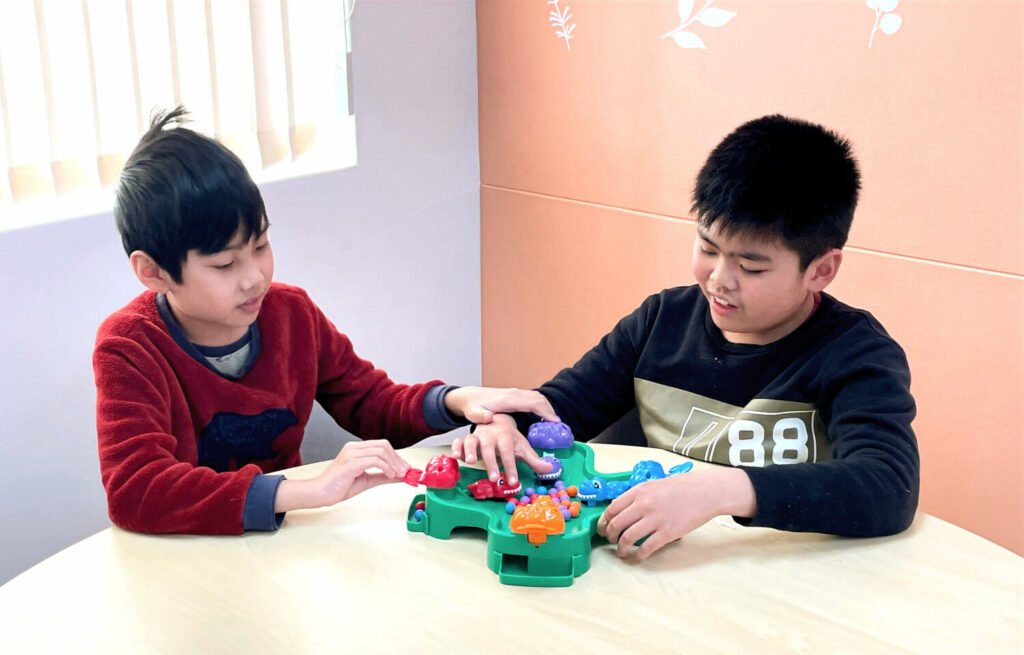
10 Language Stimulation Tips

Are you wondering about some easy things that you can do each day with your little one to help build their language skills? Here they are! There is no need to do big extra activities, just build some of these into your day and you can help your little one develop some beautiful new skills. Here are my top 10 that I teach Mums in speech sessions every week:
1. Follow your child’s lead:
This is all about taking a moment to watch your child and think about what they are interested in before you jump in and communicate with them. Sometimes we are so keen to model words that we forget to stop and consider what our child is really thinking about at the time.
If you child already has their attention on something and is interested in it, then it’s prime time to jump in and model that word for them so they can connect it to the situation.
For example: if your child points up to the trees when there is a bird sound you could say “bird” or “I hear a bird” depending on their level.
Once you have watched to see what they are interested in you can also expand on these interests in the activities that you provide e.g. you could go home and read a book with some birds in it.
2. Give a turn:
This one is all about pausing and giving your child a chance to communicate. Conversations are based on turn taking between the people in the conversation, so it is great for children to develop this skill early. Even if they are not using words yet you can give them an opportunity to communicate in a way that they can e.g. using a gesture or making a sound.
Often I see little ones who are not talking much simply because they don’t have the opportunity – maybe everything is given to them all the time so they don’t need to ask, or there are other enthusiastic siblings doing lots of talking.
If you’re a chatterbox like me, you might be tempted to chatter away at your child all day, which is great, but you could be missing out on some moments for them to express themselves!
Here are some really practical things to try:
⭐️ Stop halfway through singing a song and see if they will sing the next part or do the next action to keep it going.
⭐️ Give a choice of two snacks/ toys (even if you know which one they will choose) it’s a good opportunity to communicate.
⭐️ Pause when reading books to see if they will point to something or make a comment.
⭐️ Forget to give them something that you usually give them e.g a spoon at the table to encourage them to ask for it.
3. Repeat:
This tip is about repeating words / books / games to help your little one learn them. Research shows that repetition helps our brains to absorb new language and increases our vocabulary.
Can you think of a book or game that you have played with your little one over and over again?
It’s tempting to think that this is pointless because it’s the same every time, but don’t worry!! This is an important part of learning and your little one loves to interact with you and hear your voice saying those words. So, don’t be worried about repeating the same things – this is actually helpful to your child.
Here are some practical ideas:
⭐️ Have some of the same books available that they love as well as changing some of them over to expand interests.
⭐️ Repeat the same word in a lot of different activities e.g. “go” when you are playing with a ball, rolling a car along or starting to dance.
⭐️ Use the same words every time when you are playing a particular game e.g. “one two three go” when you are playing a chasing game.
⭐️ Sing the same songs at a particular time of day so they can pick them up e.g. the pack away song, the weather song in the morning.
4. Add on:
Add on to the language that your little person is using. Listen to the word / idea that they express and then add on an extra one.
For example; if your child says one word then you could say two words. If they use a simple sentence you could add in another word to that sentence.
Here are some examples:
⭐️ If your child says “go” you could say “go car” or “go outside” referring to the thing that they are talking about.
⭐️ If your child says “look bus” 🚌 you could say “look big bus”
⭐️ If your child hears a plane ✈️ and points to the sky (but they are not talking yet) you could model the word “plane”
⭐️ If you have an older child who is talking more you could demonstrate to them how they could make a sentence with more detail than what they already said.
5. Get face to face
This one is all about considering how you can get on the same level as your child so that you can see each other’s faces 👶
Why is this important?
⭐️ It helps your little one to see your facial expressions and movements that your mouth and face makes when you are talking to them.
⭐️ It helps you to hear and see the messages that your child is expressing.
⭐️ It lets your child know that you are interested and ready to hear their message.
Some practical tips:
😃 Getting down on the floor with them when you are playing can be really helpful.
😃 Work out how you can sit your child towards you when you are reading books so they can see your face and the book.
😆 Sit down with them when they are eating at the table so you can see each other’s faces.
6. Make it fun:
This one is about keeping language learning FUN!! 🥳
When we create fun experiences for our child and model language in these situations then they are much more willing to want to give new words a try!
This doesn’t mean you have to be creating extravagant big new activities every day- if you use the previous tips to engage with your child around the topics that they are interested in it makes learning fun for them.
Avoid questioning them too much e.g. “what’s this?” and asking them to say words. This can create an environment where children can feel pressured and actually want to communicate less. Instead of this you can model some words and pause to give them a turn. If they don’t say anything then just continue on with modelling. 😃
7. Interpret
This one is about watching what your child is doing and seeing what they are trying to communicate and then modeling that word / message.
For example if they point to the kitchen when it is getting close to dinner time you could model “I’m hungry” or “food”
This helps your child to see that you are responsive to what they are thinking about and gives them an example of what they could say in that situation.
When I talk about this with parents sometimes they ask, ‘what if I am not sure what my child is trying to communicate?’ This is a good question – sometimes we might not know exactly, but we can still say an example that could be relevant to teach them some new words. 👍
8. Imitate
This one is a great tip to try out when you might be finding it difficult to get an interaction going with your child. Copying can help them to become interested in what you are doing and want to interact with you.
You could imitate the sounds or actions that your baby / toddler is making and see if they become more aware and responsive to you. When you get a back and forth interaction going then you are starting to build the skills for future conversations!
You can imitate in play as well. For example, If they are rolling a car along the ground by themselves then you could join in and do the same thing with another car. This shows them that you are ready to play and want to join in with what they are already doing.
I’m sure if you have little ones you will know how great they are at imitating the things that you do too – this helps them to learn so many things.
9. Use their interests:
We all love talking about the things that we are interested in – like the hobbies that we have or the exciting places that we have been too. Children are the same – they are more motivated when they are talking about things that they like.
This tip is about including the interests that your child has when you are practising words.
For example, if they love cars and you want to introduce new action words then you could move the cars in different ways and talk about what the cars are doing.
If they love animals then you could go and look at the animals in that park or at the zoo. You could also go to the library and find some books about animals to read together or watch a nature show together and talk about what you see.
10. Use Gestures
Research shows that the development of gestures in children is closely linked with language development. Children learn gestures (such as pointing) before they learn to talk and continue to use them along with their speech throughout their lives.
A great way to help your child to learn gestures is to show them how to use them in everyday situations. You could use baby sign language or you could just make up gestures that make sense to you, both are beneficial!
Here are some practical tips:
⭐️ Model simple gestures such as pointing when reading books or when you see interesting things from when your child is a little baby.
⭐️ Pair gestures with speech – speaking at the same time will help your child to learn the words.
⭐️ Use gestures that demonstrate the meaning of the word e.g. pretending to hold a ball while saying “ball” or flapping your arms for “bird”
⭐️ Be consistent – use the same gestures for the same items in your daily routines and your children will be able to pick them up!
That’s the summary of all 10 tips for you. If you have any questions or want to know something more specific for your child feel free to message us!
Our Latest Articles


Is Group Therapy Effective?
Olivia Green

Feeding Tips for Picky Eaters
Olivia Green
